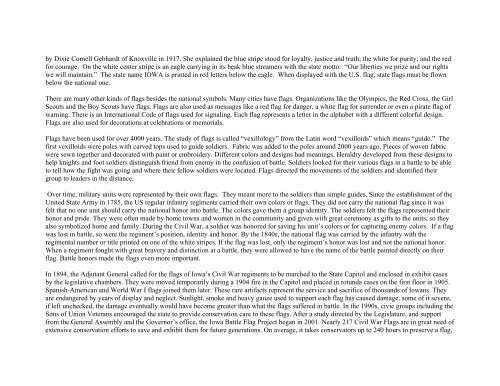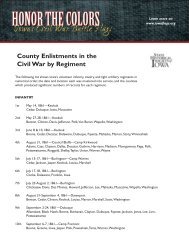Study of Flags - State Historical Society of Iowa
Study of Flags - State Historical Society of Iowa
Study of Flags - State Historical Society of Iowa
You also want an ePaper? Increase the reach of your titles
YUMPU automatically turns print PDFs into web optimized ePapers that Google loves.
y Dixie Cornell Gebhardt <strong>of</strong> Knoxville in 1917. She explained the blue stripe stood for loyalty, justice and truth; the white for purity; and the red<br />
for courage. On the white center stripe is an eagle carrying in its beak blue streamers with the state motto: “Our liberties we prize and our rights<br />
we will maintain.” The state name IOWA is printed in red letters below the eagle. When displayed with the U.S. flag, state flags must be flown<br />
below the national one.<br />
There are many other kinds <strong>of</strong> flags besides the national symbols. Many cities have flags. Organizations like the Olympics, the Red Cross, the Girl<br />
Scouts and the Boy Scouts have flags. <strong>Flags</strong> are also used as messages like a red flag for danger, a white flag for surrender or even a pirate flag <strong>of</strong><br />
warning. There is an International Code <strong>of</strong> flags used for signaling. Each flag represents a letter in the alphabet with a different colorful design.<br />
<strong>Flags</strong> are also used for decorations at celebrations or memorials.<br />
<strong>Flags</strong> have been used for over 4000 years. The study <strong>of</strong> flags is called “vexillology” from the Latin word “vexilloids” which means “guide.” The<br />
first vexilloids were poles with carved tops used to guide soldiers. Fabric was added to the poles around 2000 years ago. Pieces <strong>of</strong> woven fabric<br />
were sewn together and decorated with paint or embroidery. Different colors and designs had meanings. Heraldry developed from these designs to<br />
help knights and foot soldiers distinguish friend from enemy in the confusion <strong>of</strong> battle. Soldiers looked for their various flags in a battle to be able<br />
to tell how the fight was going and where their fellow soldiers were located. <strong>Flags</strong> directed the movements <strong>of</strong> the soldiers and identified their<br />
group to leaders in the distance.<br />
Over time, military units were represented by their own flags. They meant more to the soldiers than simple guides. Since the establishment <strong>of</strong> the<br />
United <strong>State</strong> Army in 1785, the US regular infantry regiments carried their own colors or flags. They did not carry the national flag since it was<br />
felt that no one unit should carry the national honor into battle. The colors gave them a group identity. The soldiers felt the flags represented their<br />
honor and pride. They were <strong>of</strong>ten made by home towns and women in the community and given with great ceremony as gifts to the units, so they<br />
also symbolized home and family. During the Civil War, a soldier was honored for saving his unit’s colors or for capturing enemy colors. If a flag<br />
was lost in battle, so were the regiment’s position, identity and honor. By the 1840s, the national flag was carried by the infantry with the<br />
regimental number or title printed on one <strong>of</strong> the white stripes. If the flag was lost, only the regiment’s honor was lost and not the national honor.<br />
When a regiment fought with great bravery and distinction at a battle, they were allowed to have the name <strong>of</strong> the battle painted directly on their<br />
flag. Battle honors made the flags even more important.<br />
In 1894, the Adjutant General called for the flags <strong>of</strong> <strong>Iowa</strong>’s Civil War regiments to be marched to the <strong>State</strong> Capitol and enclosed in exhibit cases<br />
by the legislative chambers. They were moved temporarily during a 1904 fire in the Capitol and placed in rotunda cases on the first floor in 1905.<br />
Spanish-American and World War I flags joined them later. These rare artifacts represent the service and sacrifice <strong>of</strong> thousands <strong>of</strong> <strong>Iowa</strong>ns. They<br />
are endangered by years <strong>of</strong> display and neglect. Sunlight, smoke and heavy gauze used to support each flag has caused damage, some <strong>of</strong> it severe,<br />
if left unchecked, the damage eventually would have become greater than what the flags suffered in battle. In the 1990s, civic groups including the<br />
Sons <strong>of</strong> Union Veterans encouraged the state to provide conservation care to these flags. After a study directed by the Legislature, and support<br />
from the General Assembly and the Governor’s <strong>of</strong>fice, the <strong>Iowa</strong> Battle Flag Project began in 2001. Nearly 217 Civil War <strong>Flags</strong> are in great need <strong>of</strong><br />
extensive conservation efforts to save and exhibit them for future generations. On average, it takes conservators up to 240 hours to preserve a flag,
















